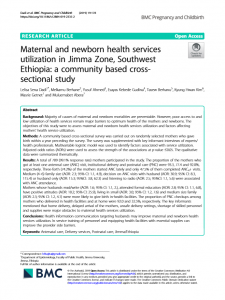
Background
The majority of causes of maternal and newborn deaths are preventable. However, poor access to and low utilization of health services remain major barriers to optimum health for women and newborns. The objectives of this study were to assess maternal and newborn health services utilization and factors affecting mothers’ health service utilization.
Methods
A community based cross-sectional survey was carried out on randomly selected mothers who gave birth within a year preceding the survey. The survey was supplemented with key informant interviews of experts/health professionals. A multivariable logistic model was used to identify factors associated with service utilization. Adjusted odds ratios (AORs) were used to assess the strength of the associations at p-value ≤0.05. The qualitative data were summarized thematically.
Results
A total of 789 (99.1% response rate) mothers participated in the study. The proportion of the mothers who got at least one antenatal care (ANC) visit, institutional delivery and postnatal care (PNC) were 93.3, 77.4 and 92.0%, respectively. Three-forths (74.2%) of the mothers started ANC lately and only 47.5% of them completed ANC4+ visits. Medium (4–6) family size (AOR: 2.3; 95% CI: 1.1, 4.9), decision on ANC visits with the husband (AOR: 30.9; 95% CI: 8.3, 115.4) or husband only (AOR: 15.3; 95%CI: 3.8, 62.3) and listening to radio (AOR: 2.5; 95%CI: 1.1, 5.6) were associated with ANC attendance.
Mothers whose husbands read/write (AOR: 1.6; 95% CI: 1.1, 2.), attended formal education (AOR: 2.8; 95% CI: 1.1, 6.8), have positive attitudes (AOR: 10.2; 95% CI: 25.9), living in small (AOR: 3.0; 95% CI: 1.2, 7.6) and medium size family (AOR: 2.3; 95% CI: 1.2, 4.1) were more likely to give birth in-health facilities. The proportion of PNC checkups among mothers who delivered in health facilities and at home were 92.0 and 32.5%, respectively. The key informants mentioned that home delivery, delayed arrival of the mothers, unsafe delivery settings, shortage of skilled personnel and supplies were major obstacles to maternal health services utilization.
Conclusions
Health information communication targeting husbands may improve maternal and newborn health services utilization. In service training of personnel and equipping health facilities with essential supplies can improve the provider side barriers.